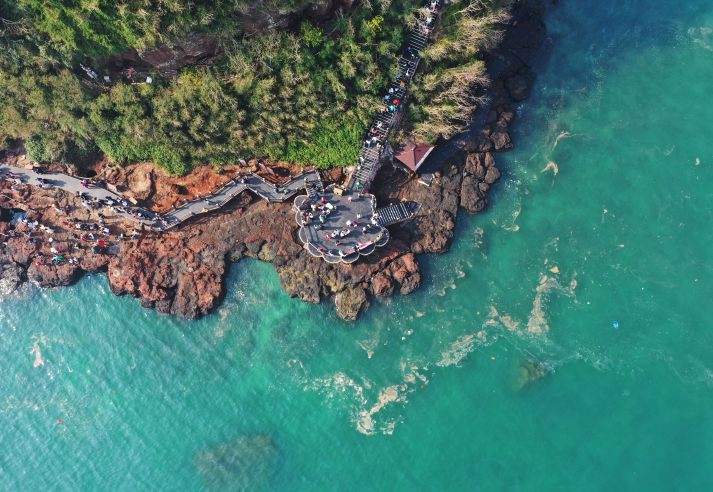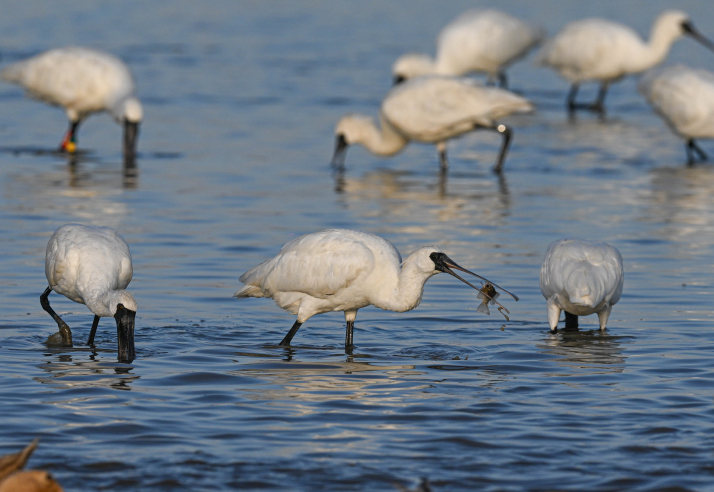| China |
| China's coastal bays lead the way in marine conservation | |
|
|
 An aerial drone photo shows a view of Weizhou Island in south China's Guangxi Zhuang Autonomous Region on January 19 (XINHUA)
Bryde's whales have now become regular visitors to Weizhou Island in Beihai, Guangxi Zhuang Autonomous Region. Every November, these marine giants, measuring 8 to 12 meters in length, appear in the surrounding waters to give birth and nurture their young, staying until April of the following year. As one of the world's most mysterious baleen whales, Bryde's whales were first monitored on Weizhou Island in the spring of 2018. Previously, due to overhunting and marine ecological degradation, their population had declined to critically endangered levels, making sightings in Chinese waters extremely rare. Currently, the number of Bryde's whales around Weizhou Island has increased from an initial six to over 60. This region is now the only known stable feeding and nursery ground for Bryde's whales in China. Every year during the whales' visit, tourists flock to the area to observe them.  A flock of black-faced spoonbills forage at a wetland in Danzhou, south China's Hainan Province, on January 13(XINHUA)
Marine renaissance The return of Bryde's whales has been attributed to the improved ecological environment of Weizhou Island's waters. Lan Wenlu, Director of the Guangxi Marine Environmental Monitoring Center, has been engaged in marine environmental monitoring for 17 years and has witnessed the ecological improvements in the area. He revealed that since 2012, the region put in place ecological red lines—legally designated areas of ecological significance, to limit destructive development activities; and carried out coral reef restoration projects, establishing coral reef protection zones and regulating tourism and fishing activities. As the ecological environment improved, marine species in the area gradually increased. "The increase in marine species has become a key factor in the appearance of Bryde's whales," he told newspaper Guangxi Daily. "Research has found that the waters near Weizhou Island are abundant in fish, especially from September to April of the following year. Schooling fish favored by Bryde's whales, such as anchovies and sardines, are widely distributed in these waters, attracting the whales to feed during specific seasons." The quality of the marine ecological environment of Guangxi has ranked among the best in the country in the recent 12 consecutive years. The area is also home to rare species such as Chinese white dolphins and horseshoe crabs, and it is one of China's most biodiverse marine regions. Today, traveling to Beihai to observe whales has become a distinctive cultural and tourism feature of the region during November to April. Mother whales and their newborn calves, with their bluish-gray backs cutting through the waves, create a unique spectacle in the area. On January 25, Weizhou Island was recognized as one of the third batch of Beautiful Bay ecological cases announced by the Ministry of Ecology and Environment. The Beautiful Bay initiative, launched in China in 2021, aims to create pristine coastal environments characterized by clear seawater, clean beaches and thriving habitats for fish and seabirds, fostering harmony between humans and the ocean. Since its inception, bay-specific policies have been implemented to coordinate nearshore pollution control, ecological conservation and restoration, and the environmental remediation of shores and beaches. The Plan for Marine Eco-Environmental Protection During the 14th Five-Year Plan (2021-25) period has divided nearshore areas into 283 bay units, integrating the construction of Beautiful Bays into the broader vision of building a Beautiful China. The plan sets a mid-term target of building 40 percent of these bays into Beautiful Bays by 2027, while all of them will become Beautiful Bays by 2035. To ensure effective oversight, an administration platform for building Beautiful Bays has been established. Utilizing on-site surveys and remote sensing monitoring, authorities track progress, implement smart supervision, and urge local governments to adopt comprehensive bay management strategies tailored to their specific conditions. Progress has been steady. By the end of 2023, approximately half of the 1,682 key tasks and construction projects had been completed. This included the improvement and restoration of 475 km of coastlines and 16,700 hectares of coastal wetlands. At least 85 percent of the sea areas in 167 bays achieved good to excellent water quality, with 102 bays showing further improvements compared to 2022. Eco-transformation Another bay added to this year's Beautiful Bay list is on Dachen Island, located in Taizhou, Zhejiang Province. With more than 30 bays, Zhejiang has the longest coastline of all of China's province-level regions. However, the province faces unique challenges in building Beautiful Bays due to its geographical conditions. Sediment from the Yangtze River estuary and Hangzhou Bay struggles to settle, negatively impacting the water quality of nearshore areas. Additionally, the dense population and industrial activities along the coast historically placed significant pressure on marine pollution control efforts. Huang Haibin, a 60-year-old fisherman from Dachen Island, ended his fishing career a decade ago and shifted his focus to marine waste collection, converting his fishing boat into a garbage cleanup vessel. The plastic waste he collects has been processed under the "Blue Cycle" model, a pioneering marine plastic governance model that originated on Dachen Island in 2022 and earned the United Nations' Champions of the Earth award in 2023. Under the model, plastic marine debris are processed into plastic pellets, and ultimately turned into recycled products, creating a sustainable and circular value chain. "Previously, the Dachen Island was more pristine, but as the island gains more recognition, we are exploring ways to balance development with conservation," Ye Lifan, Deputy Mayor of Dachen Town on Dachen Island, told newspaper Zhejiang Daily. Another key project in bay restoration on the island is the creation of artificial beaches, which not only protect the coastline from erosion but also serve as the foundation for ecological landscapes. Since 2020, Zhejiang Dachen Island Development and Construction Group Co. Ltd. has been responsible for implementing ecological restoration projects. After identifying three beach locations, the team spread over 200,000 cubic meters of sand along a 908-meter sandy shoreline. For open beaches, they carefully laid artificial reefs and larger soft stones at the base to minimize sand loss, displacement and siltation. "Dachen Island's coastline has undergone a remarkable transformation," Ye said, highlighting the island's unique ecological resources, which have made its yellow croaker and mussels highly renowned. The island also launched the "Dual Carbon" Digital Platform, designed to monitor and manage carbon emissions and carbon sequestration in real time, optimizing resource use and promoting sustainable development. Yi said the island has implemented a series of innovative projects, including fully electric aquaculture, fully electric homestays, fully electric scenic areas and fully electric transportation, driving a shift toward low-carbon production and lifestyles. "Despite the thriving of industries like aquaculture and tourism in recent years, the integration of environmental protection measures has ensured they do not add pressure to the ecological environment," Yi said. Copyedited by G.P. Wilson Comments to yuanyuan@cicgamericas.com |
|
||||||||||||||||||||||||||||
|